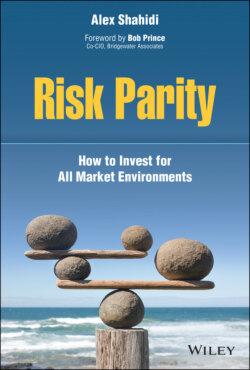Читать книгу Risk Parity - Alex Shahidi - Страница 28
Four Diverse Asset Classes
ОглавлениеThere are numerous asset classes to pick from. The key question is how we can take advantage of diversification across various asset classes to reduce risk. Our goal isn't to select or weight them based on return or risk but based on how they diversify each other (i.e., what drives their performance). The core observation is that asset classes have two key drivers in common – growth and inflation – and what distinguishes them from each other is how they respond to those drivers.
Based on this logical sequence and our desire to build a well‐diversified portfolio, the next natural step is to select a group of assets that perform differently from each other because they respond differently to changes in growth and inflation. By temporarily ignoring the returns and risks of various asset classes (in contrast to the way most people think about building a portfolio), the steps should seem reasonable and, in many ways, very obvious.
There are four general economic environments that should be considered: rising growth, falling growth, rising inflation, and falling inflation. There are four asset classes that cover these economic outcomes:
1 Global equities – rising growth, falling inflation
2 Commodities – rising inflationIndustrial commodities – rising growthGold – falling growth
3 Treasuries – falling growth, falling inflation
4 TIPS – falling growth, rising inflation
You may notice that some commonly used asset classes like intermediate‐term core fixed income, high‐yield bonds, and real estate investment trusts (REITs) were excluded from our list. I believe Treasuries are a better environmental fit for falling growth than core fixed income because their higher credit quality means they will typically outperform during extreme adverse environments like 2008 and first quarter 2020. High‐yield bonds have the same bias as equities (rising growth, falling inflation) since their returns are largely driven by changes in creditworthiness, so they don't add much incremental benefit from a diversification standpoint. You'll see later when we discuss returns that they also have a lower return profile and are less tax efficient than equities, which is another reason to exclude them. REITs also are similar to equities in terms of how they respond to shifting economic environments. This one is a closer call because real estate is a real asset and has some inflation‐hedging components. However, real estate is often purchased with debt, which makes it sensitive to rising interest rates, and rents can often lag inflation – particularly with fixed, longer‐term leases. Therefore, it has historically not provided as reliable and consistent an inflation hedge as TIPS and commodities, which are included in our mix of assets.
